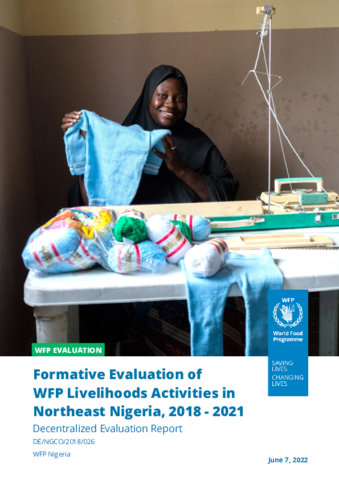
The analysis was structured around six standard criteria for evaluating humanitarian operations: appropriateness, effectiveness, efficiency, connectedness, coverage, and coherence.
Overarching evaluation questions included:
- Was the livelihoods activity aligned with WFP livelihood and resilience guidance, and was the transfer modality, needs, and design appropriate for the context (appropriateness)?
- Did the livelihoods activities achieve the expected outputs and outcomes (effectiveness)?
- Was the livelihoods activity technically relevant to needs, and did WFP Nigeria and partners fulfil their complementary roles (efficiency)?
- Is the transitional strategy which forms the targeting criteria of the livelihoods activity, able to support or contribute to peace and stability, social cohesion, and sustainable livelihoods (connectedness)?
- Was the targeting criteria of the livelihoods activity consistent with the needs of beneficiaries (coverage)?
- Did the livelihoods activity consider the context for implementation, and was it in line with humanitarian principles (coherence)?
Overarching findings include the following:
- Livelihoods activities are helping beneficiaries to meet immediate food needs, but they seem to have limited success in restoring the key productive assets needed for sustained livelihood activities. There is a widespread view that the intervention was too short to have lasting effects.
- In many instances, beneficiaries were given livelihood assets without the complementary capacity strengthening that would sufficiently position the beneficiaries with the basic technical competence and managerial skills to facilitate their entrepreneurial success.
- Women were empowered by the livelihoods activities, but to varying extents. Membership of most Project Management Committees (PMC) included at least 50 percent women, though, in the cultural context, ensuring that women's voices are heard remains a challenge. Given heavy domestic burdens, women require more flexibility in the timing and scheduling of individual and, especially, communal work.
- The monitoring and evaluation of outcomes and impacts could be improved by the collection of data on key indicators at the baseline and end-line of livelihood activities from both beneficiaries and non-beneficiaries. This would enable rigorous analysis of the impacts of the livelihoods activities in a way that is clearly attributable to the intervention.
Key recommendations from the evaluation are:
R1: Refine the targeting approach to better ensure the inclusion of vulnerable groups such as women, youth, elderly, and PwD
R2: Increase the implementation timeframe.
R3: Strengthen capacity comprehensively to enable beneficiaries gain adequate technical knowledge to grow sustainable and viable businesses.
R4: Strengthen gender-responsiveness in programming.
R5: Improve future evaluation of the livelihoods activity to measure impacts that are attributable to the intervention.
R6: Scale up livelihoods activities, with flexibility to build on the progress and lessons learnt from the current activities, and with adjustments for each local context and types of beneficiaries.
